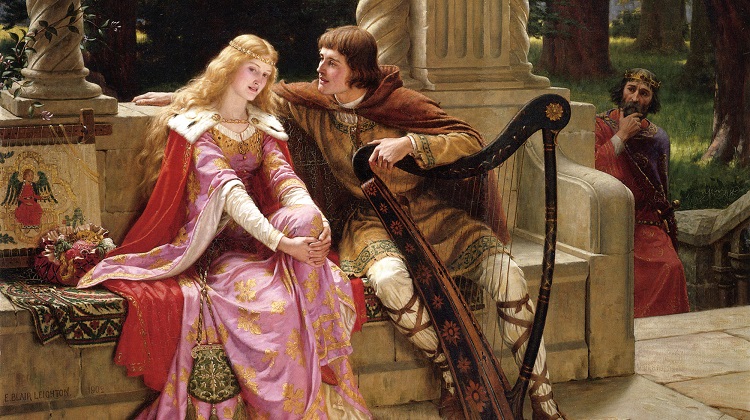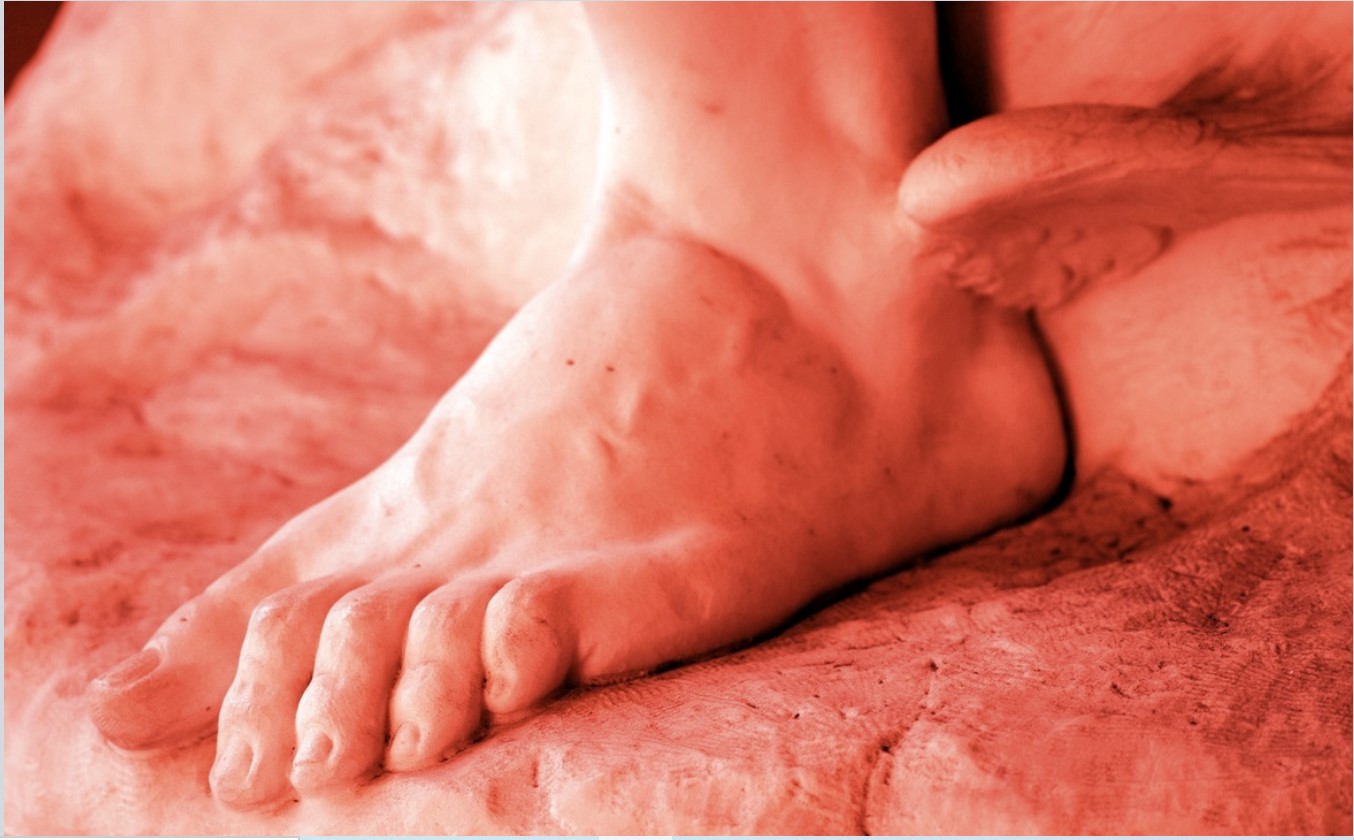The following is from the introduction of Sarah K. Balstrup’s thesis To ‘Believe’ in Love – The Religious Significance of the Romantic Love Myth in Western Modernity. In it she explores romantic love as the dominant religious belief system in the Western world today. – PW.

THE STUDY OF LOVE
In 2011, Simon May made the bold claim that “love has increasingly filled the vacuum left by the retreat of Christianity…so that it is now the West’s undeclared religion – and perhaps its only generally accepted religion.”4 Although May’s research engages with philosophical debates rather than the more sociological concerns of the scholar of religion, his observations provide an excellent starting point for deeper analysis into this seemingly new religious phenomenon.
What is the significance, for instance, of the fact that May refers to love as ‘the’ religion of the West, and the simultaneous claim that such a widespread belief system can remain unrecognised by its adherents? Moreover, what is meant by ‘love’? This thesis seeks to answer such questions and, in doing so, provide a comprehensive analysis of the socio-cultural changes that have occurred between the mid-nineteenth century and the present day that have fundamentally altered both the significance of love, and the nature of religion itself. As the subject of study, love is defined as a particular social mythology that has achieved religious status due to important epistemological shifts associated with secularisation.5
Through the consideration of a number of case studies, including Gustave Flaubert’s Madame Bovary (1856), the HBO series Sex and the City (1998-2004), and romantic comedy films, the religious function of love will be investigated. As a social mythology that effectively replaces the Christian symbolic, love will be appraised as a religious position, on the basis that it acts as an ultimate concern for Western individuals.6 Most importantly this will involve an analysis of the religious epistemological mode in order to demonstrate why the ‘love religion’ does not involve self-identification.
Typically understood as an emotional state, love has become an important topic of philosophical, religious and psychological investigation throughout Western history. While far from exhaustive, such a history might include examples from the Biblical Scriptures, Plato’s Symposium, Dante’s Commedia, the tradition of courtly love that emerged in eleventh century Europe, along with a host of examples from the Romantic poets,7 and humanist philosophers.8
As love has acquired a rich symbolic resonance through the influence of such discourse, it has variously been understood to be an aspect of the Christian symbolic system, a state of being associated with truth, sacredness and beauty,9 or as an ethical force that is human in origin. To consider the implications of each of these examples within their cultural context is an unwieldy task, yet one that has been tackled by numerous academics in the past thirty years, as well as in earlier studies such as C. S. Lewis’s Allegories of Love (1936)10 and Denis de Rougemont’s Passion and Society (1956).11 More recent studies of import include Stephen Kern’s The Culture of Love: Victorians to Moderns (1992)12 and Simon May’s Love: A History (2011),13 as well as a host of philosophical14 and socio-cultural studies.15
While these texts will inform this thesis, in general, their aim has been to extrapolate the culturally specific nature of the Western understanding of love, where ‘religion,’ in its Judeo-Christian form, is understood to be one of many influences upon the myth. In light of Wittgenstein’s assertion that “the meaning of a word is its use in language,”16 it becomes apparent that the survival of ‘religious themes’ does not necessarily prove the continuation of religious significance. Rather, in this thesis, the love myth is deemed to be a coherent symbolic system that functions as a type of secular religion, regardless of the origin of ideas that comprise its current form, which may or may not have been religious in their original cultural context.
Despite the depth and breadth of studies on love, and the frequent claim that love is of sacred or religious significance,17 the definition of love remains vague and the dynamics of this supposed religious connection have yet to be fully explored. Those who have made the strongest claims regarding love’s spiritual significance have done so with disapproval, in the case of de Rougemont,18 May19 and others; or an air of tragedy, as can be found in the reflections of Flaubert,20 Michel de Certeau and Roland Barthes.21 The former find fault with the love myth, claiming that it puts unrealistic expectations upon human relationships,22 that it is an inferior and adulterated version of a purer religious sentiment,23 that it is a corrupting influence in society which involves the human attempt to become God,24 or is otherwise responsible for human cruelty.25
In each case, love and relationships are viewed to be separate from the culturally contingent love myth that is being subjected to critique. As a Religious Studies approach does not involve the evaluation of belief systems based on their putative merit, these arguments will not be explored; however, it is important to note the contested nature of the religiosity of love. As a ‘growing trend,’ the sacralisation of love is then identified as an undesirable development that must be studied in order to create a level of reflexivity necessary to stem the flow of its influence.
Although the majority of scholars mentioned thus far simply use the term ‘love,’ and may mention culturally specific sub-categories such as agape, eros, or parental love, the contemporary form of love that is increasingly idealised can be more accurately defined as ‘romantic love.’ As a cultural construct, romantic love has a history that can be most clearly traced to eleventh century Provence, when the love poetry of the troubadours began to depict a noble and divine love between man and woman that stood in contrast to the dry practicalities of arranged marriage.26
Medieval scholars have problematised this reductive claim, and have revealed aspects of the courtly tradition that do not serve to convey the more modern notion of romance, yet, the concept of the birth of romance has remained a useful periodisation tool nonetheless.27 As courtly love was an adulterous, albeit unconsummated love that stood in contrast to the institution of marriage, romantic love is based upon passionate feelings towards an idealised other, involving a self-sacrificing attitude of devotional awe. Tristan and Isolde provides the most iconic example of courtly love, and due to the tragic culmination of this lovers’ tale, there has remained a strong link between romantic sentiment and the concept of being reunited with the beloved through death.
While not always mentioned regarding the origins of romantic love, there is a very close relationship between courtly love poetry and the writings of medieval mystics like Bernard of Clairvaux and Hadewijch of Antwerp.28 Incorporating Biblical material such as the erotically charged “Song of Songs,” Christian mystics have developed strong associations between devotion for the beloved (as lover), and the Beloved (as Christ or the Deity himself).29 This form of romantic worship drew strongly on Platonic philosophy, wherein erotic desire for the beauty that resides within the beloved can lead the lover to purer states of love, and, ultimately, to the contemplation of the Divine. As influential strains of Christian mysticism appropriated this model of sacred relation,30 the concept of ascent via beauty intermingled with Christian concepts of the Divine, and this association has remained salient in Western cultural mythology.
The poetry of the courtly tradition and the writings of Christian mystics are historical antecedents of the idea of romantic love, however, in mid-eighteenth century England, romantic love came to be understood in terms of human relationships. Related to the rise of the middleclass, the birth of the modern novel, and other factors associated with modernisation, romantic love became a driving force of social change as it became increasingly acceptable to marry for love.31
Previously constrained by the class system and the social obligation to enter into practical marriages, in the mid-eighteenth century, the law of love became more deeply associated with virtue than the ability to conform to the dictates of the social institution. In this early period the ideal of true love was applied to the dissolution of class-based distinctions, and this deregulatory function has become characteristic of the love myth, so that in the contemporary context, romantic love is employed in the rejection of all forms of social barriers. In the realm of popular culture, the romantic comedy has offered a running commentary on the love myth since the establishment of the genre in Hollywood’s classical era.32
Depicting strong female leads in the 1930s and ambitious career women in the 1980s, the romantic comedy genre has a history of correlating the overthrow of patriarchal dominance with the negotiation of ‘true’ love.33 Films from the 1990s onward have extended the use of the romantic love myth to dismantle social barriers relating to race, gender, sexuality, age, and cultural extraction. As such, the love myth has been consistently identified as a force of justice that enables the individual to oppose social sanctions.
As the history of the love myth does not in itself define the specific types of beliefs involved in its contemporary form, examples will be provided of what romantic love is considered to be within the bounds of this thesis. First and foremost it is believed that true love can be found between two people, and that the connection that they share involves the total person; physical, spiritual, mental. These two individuals are destined to be together and are led into contact with one another through divine aid or coincidence, so that all life events can be understood in relation to the formation of a relationship that was always ‘meant to be.’34
Romantic love requires one to surrender disbelief,35 and have faith in the power of love in order to experience this sacred relationship, and the individual expects to undergo trials of virtue in order to be worthy of such love.36 Super-empirical elements implicit in the romantic myth include a belief in destiny,37 and the ability to connect with the beloved by means of extra-sensory-perception, and a belief in postmortem reunion in the afterlife,38 or in subsequent lives.39 The universe is believed to contain knowledge of the fated union between the individual and their ‘soul mate,’40 and one can read ‘signs’ in daily life that may lead them to this person, or reveal their identity. The identity of one’s soul mate is as unique as the individual, so that uniqueness is prized over stereotypical conventions of beauty or personality.41
One may come up against innumerable practical obstacles; identifying subsequent mates as ‘the One,’ or failing to establish a connection with a person that one believes is their ‘soul mate,’42 yet the romantic myth can be manipulated successfully to absorb even the most direct contradictions. This is possible due to a belief in layers of meaning, and an ultimate underlying ‘truth’ related to the concept of the ‘true self.’ This truth can only be verified by emotional cues and personal intuition, so that if these initial feelings of confirmation are seriously tested, the individual can concede that they were fooled by the appearance of truth, and so remain unshaken in their belief that their true love is still out there.
Drawing upon the value of self-determination embedded in the ideal of freely choosing one’s partner, out of love rather than social obligation, love is heralded as a revolutionary force that can usurp institutionalised authority.43 Ultimately, true love removes the scales from one’s eyes, revealing the goodness inherent in all things, and enables one to experience Heaven on earth.44 As the mode of relation between the individual and God has been so often expressed in the Judeo-Christian tradition in romantic terms, popular culture reveals that God and the beloved have now become almost interchangeable concepts.45
____________________
REFERENCES:
4 May, Love: A History, p. 1.
5 Terms such as ‘myth,’ ‘mythology,’ ‘imaginative,’ and ‘imagination’ are not used in the pejorative sense in this thesis. While Christian polemicists have used these terms to imply a type of belief that is ‘untrue’ and based upon delusory thinking, here they are used to refer to their function. Mythology can be understood analogously to ‘social narrative,’ while imagination involves a type of active mental engagement requiring the suspension of reality.
6 Paul Tillich, ‘Dynamics of Faith,’ in Robert P. Scharlemann (ed.) Paul Tillich: Main Works, Writings on Religion (Walter de Gruyter, 1988) pp. 231–232.
7 John Keats, Percy Bysshe Shelley and others.
8 For instance, Petrarch and Auguste Comte.
9 Dante Aligheiri, The Paradiso (J. M. Dent and Sons: London, 1941); Charles Williams, Religion and Love in Dante: The Theology of Romantic Love (Kessinger Publishing, 2010); Flaubert, Madame Bovary.
10 C.S. Lewis, The Allegory of Love: A Study in Medieval Tradition (Oxford University Press, 1938).
11 Denis de Rougemont, Passion and Society (Faber and Faber, 1956).
12 Stephen Kern, The Culture of Love: Victorians to Moderns (Harvard University Press, 1992).
13 May, Love: A History.
14 For example Vincent Brümmer, The Model of Love: A Study in Philosophical Theology (Cambridge University Press: Cambridge, 1993); Albert James Smith, The Metaphysics of Love: Studies in Renaissance Love Poetry from Dante to Milton (Cambridge University Press, 1985); Richard John White, Love’s Philosophy (Rowman & Littlefield, 2001); Irving Singer, The Pursuit of Love (John Hopkins University Press, 1994).
15 For example Kern, The Culture of Love; May, Love: A History; Ann Swidler, Talk of Love: How Culture Matters (University of Chicago Press, 2001); Aaron Ben-Ze’ev and Ruhama Goussinsky, In the Name of Love: Romantic Ideology and its Victims (Oxford University Press, 2008).
16 Simon Malpas, Jean-François Lyotard (Routledge, 2003) pp. 21–22.
17 All love theorists mentioned in this thesis recognise the classic examples of sacred love enshrined in Biblical, Platonic, mystic, courtly, and Romantic sources. The centrality of love in Western culture is likewise recognised, yet each theorist articulates the ‘sacred’ or ‘religious’ role of love in a different way. Due to limitations of space, May’s claim is singled out for its directness and clarity.
18 de Rougemont, Passion and Society.
19 May, Love: A History.
20 As will be discussed in further detail in the second chapter of this thesis, Flaubert’s views of love are tragic, idealistic, cynical and ironic. Evidence of this can be found in all of his written works, particularly Madame Bovary (1856) and A Sentimental Education (1869) yet also in his extensive collected correspondence. See John Charles Tarver, Gustave Flaubert as seen in his Works and Correspondence (Kessinger Publishing, 2005).
21 Michel de Certeau, The Mystic Fable: Volume One: The Sixteenth and Seventeenth Centuries (University of Chicago Press, 1995); Barthes, A Lover’s Discourse. As this thesis merely cites de Certeau and Barthes in order to engage with their personal representations of the love myth, their broader theoretical oeuvres will not be considered. Recognising that French theory has contributed much to the study of love, thinkers like Lacan, Kristeva, De Beauvoir and Foucault have been purposely omitted from this thesis in order to distinguish my methodological position from theirs, and avoid an unintended association with the strong political subtext of their writings.
22 Swidler, Talk of Love; May, Love: A History; Kern, The Culture of Love; Ben-Ze’ev and Goussinsky, In the Name of Love.
23 de Rougemont, Passion and Society.
24 May, Love: A History.
25 Ben-Ze’ev and Goussinsky view the “romantic ideology” of love to be responsible for “wife murders” and violence perpetrated against women in the name of love. Ben-Ze’ev and Goussinsky, In the Name of Love.
26 Swidler, Talk of Love, pp. 112–135.
27 Stephen C. Jaeger, Ennobling Love: In Search of a Lost Sensibility (University of Pennsylvania Press, 1999); Lewis, The Allegory of Love.
28 Gordon Rudy, Mystical Language of Sensation in the Later Middle Ages (Routledge, 2002) pp. 68–72.
29 Louise Nelstrop, Kevin Magill, and Bradley B. Onishi, Christian Mysticism: An Introduction to Contemporary Theological Approaches (Ashgate, 2009) pp. 89–90.
30 Nelstrop, Magill, and Onishi, Christian Mysticism, pp. 23–27, 85–91.
31 Colin Campbell, The Romantic Ethic and the Spirit of Modern Consumerism (Blackwell, 1989) p. 27.
32 Claire Mortimer, Romantic Comedy (Taylor & Francis, 2010) p. 10.
33 Chantal Cornut-Gentille, ‘Working Girl: A Case Study of Achievement by Women? New Opportunities, Old Realities’ in Peter William Evans and Celestino Deleyto (eds) Terms of Endearment: Hollywood Romantic Comedy of the 1980s and 1990s (Edinburgh University Press, 1998) pp. 111–128.
34 Before Sunrise (1995) tells the story of Jesse and Celine who meet by chance on a train in Europe. They spend one night together, yet their entire lives are rewritten in relation to this event. Failing to reunite in Vienna the following year, in Before Sunset (2004) the couple eventually meet in Paris to find that the nine years that they had spent apart were filled with dissatisfaction and that their chance at happiness depends upon their being together.
35 In romantic comedies, the initial cynicism of the romantic couple is replaced by absolute faith in the reality of love by the film’s conclusion. For example, When Harry Met Sally (1989), The Proposal (2009), Friends with Benefits (2011).
36 In the romantic comedy Joe Versus the Volcano (1990) this test takes the form of a ‘leap of faith’ where the romantic couple express their commitment to each other and to love by jumping into a volcano. Rather than dying together, this act is rewarded by unseen forces as the volcano spits them out and they survive unscathed. In the ‘real life’ context of the reality television show The Bachelor (16:7) Ben takes Kacie, Nicki and Rachel shark-swimming on their group date. Rachel has a shark phobia, yet Ben convinces her that the shark dive is a suitable metaphor for their (potential) future relationship. Despite the danger that Rachel finds herself in, she is able to utilise the psychological skills learnt from romantic narratives in order to act against her natural instinct of fear. Knowing that when one demonstrates their faith in love, they will be rewarded, Rachel puts her life in danger as she wills herself to believe that Ben’s presence will magically protect her from harm.
37 Serendipity (2001).
38 Chris and Annie reunite in What Dreams May Come (1998), while in Ghost (1990) Sam communicates with his partner Molly after his untimely death. When his spirit is about to ascend to Heaven, the couple say goodbye in the temporary sense by saying “see ya,” implying that they will meet again.
39 The Fountain. Similarly, many romantic films involve lovers meeting while one partner is in a different body, yet the true spiritual bond that they share eventually enables the recognition of the disguised beloved. In Buffy the Vampire Slayer (1997-2003) this trope is played out in a range of bodyswapping scenarios, and in the dual nature of Angel/Angelus. Similarly, in Doctor Who (2005-2009) the Doctor’s ‘true self’ is maintained through subsequent ‘regenerations.’
40 In its popular usage, this term refers to a person’s destined true love, yet is derived from Plato’s story of the original humans who were male and female; two joined together with four arms and four legs, until they were separated by Zeus. In popular culture, the term soul mate is employed to emphasise that love between two individuals is so great that no physical or metaphysical force could destroy it. In fictive form, soul mate partnerships are often depicted overcoming space, time, death, the body, or psychic barriers such as spells or Alzheimer’s disease. For example, in The Notebook (2004), The Fountain (2006), and Eternal Sunshine of the Spotless Mind (2004).
41 “For me the other is neither he nor she; the other has only a name of his own, and her own name. The third-person pronoun is a wicked pronoun: it is the pronoun of the non-person, it absents, it annuls. When I realise that common discourse takes possession of my other and restores that other to me in the bloodless form of a universal substitute, applied to all the things which are not here, it is as if I saw my other dead, reduced, shelved in an urn upon the wall of the great mausoleum of language. For me, the other cannot be a referent: you are never anything but you, I do not want the Other to speak of you.” Barthes, A Lover’s Discourse, p. 185.
42 Sliding Doors (1998).
43 In The Adjustment Bureau (2011) the authority to be overcome is that of God himself. In the film, it is revealed that angels monitor human behavior to ensure that all act according to their destiny. David and Elise state their case to the Deity and convince Him that they should be allowed to write their own destinies because they are most truly in love.
44 “In this world we’re just beginning to understand the miracle of living…Ooh, baby, do you know what that’s worth? Ooh, heaven is a place on earth. They say in heaven love comes first. We’ll make heaven a place on earth.” Belinda Carlisle, “Heaven is a Place on Earth.”
45 For example, songs that are generally understood to be about romantic love can also be read as songs about God, for instance, Florence and the Machine (“When food is gone you are my daily need. When friends are gone I know my Saviour’s love is real…You got the love I need to see me through.”) “You Got the Love,” Markita “Love, Thy Will be Done.” Similarly, in Sister Act (1992) a choir of nuns use the love songs “I Will Follow Him” and “My Guy” to refer to the Christian Deity.
Excerpt source: To Believe in Love – The Religious Significance of the Romantic Love Myth in Western Modernity, by Sarah K. Balstrup





